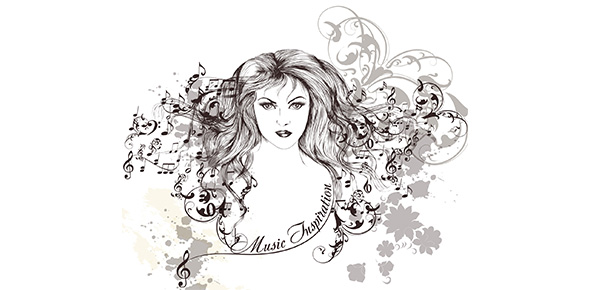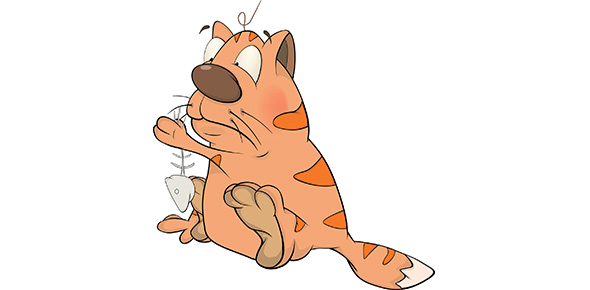Related Flashcards
Related Topics
Cards In This Set
| Front | Back |
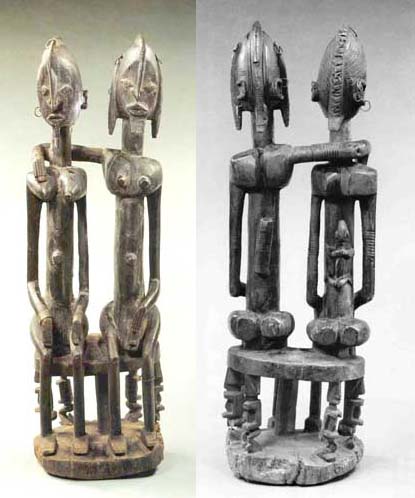 Couple |
Dogon, Seated
couple, front
and back, 19th
c. or earlier,
This image represents the Male and Female twin parts of the soul. The even balance of the duties of male and female. Here the female has a baby on her back and the male a bow and arrow. They are seated on a caryatid stool. The primordial couple, Dogon ancestors, is represented sitting on a stool, the base of which depicts the earth while the upper surface represents the sky. The seat itself is called an imago mundi and is supported by figures known as the Nommo. The Nommo, of which there are eight, are the forefathers of the entire Dogon race. Please note that the Nommo were thought to be bisexual. The female element dominate in some the male in others. The first Nommo pair constituted the Primordial Couple. The man’s right arm is around the woman’s neck and his hand touches her breast. The womans hands rests on her thighs.
|
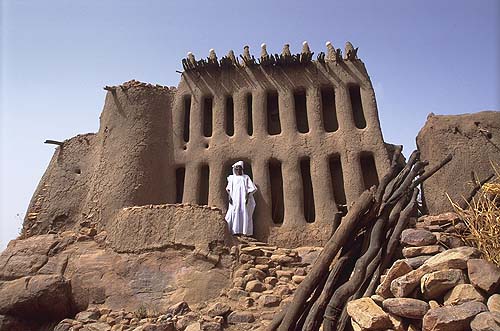 Shrine |
Dogon Binu Shrine, 20th Century, Mali
The eight holes represent the nommo, the original eight ancestors. The ostrich eggs on top represent the original egg of Amma. The man is dressed like a Hogon.
The Binu cult: uses totems, common ones for the entire village and individual ones for totem priests. A totem animal is worshipped on a Binou altar. Totems are for example the buffalo for Ogol-du-Haut, and the panther for Ogol-du-Bas. Normally, nobody will ever be harmed by its own totem animal, even if this is a crocodile as for the village of Amani. Here is a large pool of crocodiles that do not harm any villager. However, a totem animal might exceptionally harm if one has done something wrong. A worshipper is not allowed to eat his totem. For example, an individual with a buffalo as totem is not allowed to eat buffalo meat, but also not to use leather from its skin and even not to see a buffalo die. If this happens by accident he has to organise a purification sacrifice at the Binou altar. Boiled millet is offered and goats and chickens are sacrificed on a Binou altar. This colours the altar both white and red. Binou altars look like little houses with a door. They are bigger when the altar is for an entire village. A village altar has also the ‘cloud hook’, that will catch clouds and make it rain.The cult of Lebe, the Earth God, is primarily concerned with the agricultural cycle and its chief priest is called a Hogon. All Dogon villages have a Lebe shrine whose altars have bits of earth incorporated into them to encourage the continued fertility of the land. . According to Dogon beliefs, the god Lebe visits the hogons every night in the form of a serpent and licks their skins in order to purify them and infuse them with life force. The hogons are responsible for guarding the purity of the soil and therefore officiate at many agricultural ceremonies. Several patrilineages make up a clan. Clan leadership belongs to the Binu priest. His mission consists in maintaining harmony between supernatural forces of the bush and clan members. They will call on him for all kinds of problems of a mystical nature (unexplained diseases, divination, etc ...). Whereas the responsibilities of the Ginna Banga are transmitted through succession, those of the Binu priest are acquired in a very different manner :
The Binu is a supernatural and protective being that manifests itself to an individual in the form of an animal. Whilst walking through the bush, this individual will be given an object, such as a stone, as a sign of alliance (Duge). Ethnographic literature has it that the discovery of the Duge by the person in question is proof of his ability to communicate with the spirit world and that consequently it is his duty to assume responsibility as Binu priest. From there on, the new priest will wear the Duge in the form of a necklace. But in reality, the Duge is not just a stone found in the bush by a person in a trancelike state. It is rather the necklace itself which on the death of the priest, is hidden by family members until the day it is rediscovered by his successor. One says that the Binu "sleeps" until the day the Duge is rediscovered. Only one out of the three existing Binu's in Ogol-Da was active in early 2006.
Clan members have a close relationship with a totemic animal or plant (ba-binu). In "Graine de l'homme, enfant du mil-pages 33/34", J.Bouju gives the following example : In the village of Sibi-Sibi the Karambe clan's totem is a snake. One day an inhabitant of Sibi-Sibi was saved from drowning by a water serpent. It was through the animal's intermediary that the Binu manifested its alliance with the Karambe clan. Since that day, it is strictly forbidden for the Karambe to hunt, kill and consume snakes.
Binu shrines are single-chambered constructions decorated with reliefs and geometric designs. The white marks on the façades are millet gruel libations made during agrarian rites. These rites are to ensure the coming of the rain, the regeneration of nature and abundant harvests.
|
 Figure |
Dogon, Plank figure (front and back) with raised arms, 16th-17th c., Mali.
A Figure with Both Hands Up: indicates a specific demand or protection against evil. Standing Dege with raised hands: Represents Praying to the gods |
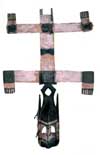 Mask |
Dogon, kanaga mask, 20th c., Mali.
In Dogon territory, the period between the death of a man and the end of the mourning ceremonies which close the funeral cycle is quite a long one. If the deceased had held an important social or religious position, or had attended the Sigui sixtieth birthday ceremonies either in his own village or in a neighboring region, then after the 'first funeral' the family will accumulate goods that can be exchanged to enable them to organize a dance. This ritual preparation period for the 'departure of the deceased man's soul' is considered dangerous for the deceased's own family and, by extension, the whole village. Numerous taboos are therefore enforced on them, while the homeless soul roams through the village, haunting the various places he once frequented. The function of the dama, apart from raising the taboos, is to master this secret force that emanates from the deceased and direct it through the medium of masks to the sacred places where it will in some way or another be fixed. At the end of the dama the deceased will belong to the ranks of ancestors. It is through them that the word of Amma, the Creator, will be transmitted again in all its vital force to mankind, fertilizing the fields and making fecund the women and the cattle. This recreation of an order that has been disturbed by death involves a wide display of symbolic practices: the deploying of masks, songs, music and an abundant consumption of food and millet beer. Sometimes the dama may last as long as six days. The beginning of the dama preparations is announced by the sound of the rhombe, which is a wooden or metal saw-edged plate whirled round at the end of a rope by one of the initiates. The humming sound of this instrument is regarded as the voice of the very first ancestor. From that moment, the circumcised members of the Awa— a mask society—repaint or carve afresh the masks that they will wear. This takes place away from the village, in rocky shelters or in the bush. The hoods and the short skirts for the costumes are made from the bark of the polio tree, and the long skirts from sanseviera fibres. These are plaited and dyed black, red or yellow. Cowries and various other ornaments are fixed to the hoods and the breastplates. When the masks emerge from the secret places where they have been fashioned, their arrival is announced in the village and the women and children take shelter in their huts, since the members of the Awa are not indulging in a gay masquerade. They are actors in a cosmic theatre, aiming to recreate the creation of the world, of men, of vegetable and animal species, and of the stars. What is happening is that this period of danger and disorder that has been brought about by the death is now brought to an end by the evocation of the fundamental moments in the genesis of the universe. The audience, enthusiastic but solemn, watches with great attention the development of the different stages in the ritual. At the dama of a spiritual chief or a village notable, the place where the sacred dances are held is invaded by an impressive number of different masks. Of these the most numerous and the most symbolic are the kanaga and the sirige masks. The kanaga is topped by a short pole to which two parallel blades are fixed perpendicularly. Two small flat boards are placed at their ends, upwards for the upper blade, downwards for the lower blade. The face of the mask is partly encircled by a crest of very stiff fibres, dyed either red or yellow. To the uninitiated, this mask evokes a bird spreading its wings. For those who have attained analogical knowledge through initiation, it is the symbol of man, axis of the world, pointing to both earth and sky. Another interpretation links kanaga to the water insect which, at the birth of the world implanted in the soil the first seed from which all other seeds and all human archetypes sprung. And the flat, crushed shape of the pole of kanaga evokes the fall of the first trouble-maker, Ogo, the pale fox. All these variations are included in one of the figures of the dance. The dancer, with a rapid movement of the upper part of the body, sweeps the mask close to the ground, thus evoking the internal vibration that animates the matter created for Amma. The sirige mask has a rectangular face divided by a vertical ridge with two hollowed spaces. It is topped by a huge blade, sometimes nearly fifteen feet high. This blade, which is alternately painted and pierced, shows patterns of parallel lines and opposing triangles. Sirige means 'storied house', and several meanings are concentrated into this term. There are the different stages of creation, the degrees severing the earth from the sky, the curve of the arch, the genetic sequence and also, in the vertical parallel lines, the frontage of the ginna or 'family house', representing by analogy the vast human family. After a few steps, and following a rapid change in the drum rhythm, the sirige mask-wearer kneels towards the east Then he moves the top of his body backwards and forwards, forcing the extreme end of the blade to touch the ground, and thus marking the limits of the horizon and the cardinal points. As he raises himself up, he creates whirling horizontal motions with the mask which suggest the evolution of the sun around the earth, analogous to the universe being created by the rotation of the divine axis. Kanaga and sirige are followed by masks that are more familiar to the uninitiated, since they are made in accordance with a less abstract concept. These masks evoke the behavior of some of the animals that haunt this part of the bush, encompassed by a loop in the River Niger. They include, among others, antelopes, hares, lions and monkeys. Other masks mime the behavior of various Dogon social characters. There is the "old man' mask, the young girl, with a face made from cowries and breasts of baobab fruits, the 'ritual thief, and the masks of caste such as the 'blacksmith', the 'shoe-maker', and so on. Foreigners, too are represented in this vast pageantry. There is the mask of the 'Peul woman', characterized by the head-dress peculiar to this ethnic group; the mask of the 'Bamana woman' and others. Sometimes there is even the 'Missus', or white woman mask, and that of the 'Doktor', the ethnographer. |
 Mask |
Represents the building of edifices in Dogon country. Very Easy to Make
|
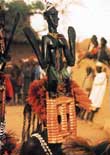 Mask |
Dogon Satimbe or "great woman" mask 20th c. Mali. Represents a woman. Alludes to the origins of the mask in Dogon Culture created by bush spirits, gave them to the black ants, buzzard stole them then a woman finds them, puts it on, scares her husband, an old woman told him where they were and he then made himself into a mask and used the power to bend his wife's will to his own. From there on masks are for men only and demonstrate dominance over women. Only men can participate in masquerades - even when a female is depicted. Since then men have appropriated the masks and the fertilizing power that they bring to ensure the crops and assist in the journey of the recent dead into the bush where they await rebirth.
|
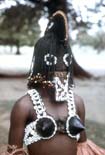 Mask |
Dodon, bedye mask, 20th c. Mali
Bedye means pupil. All the dancers will prepare a bedye which is a simple cloth mask. They wear it during the opening weeks of fire or night masks. During this period the dancers choose to construct one or more masks of the tree or other animal. The clothing of the dancers recalls the origins of the Dogon mask tradition with the pointed breasts as masks being discovered by women.
|
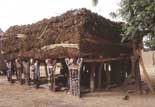 Togu Na |
Dogon, togu na c. 1980's Tenyu Irele, Mali
eight posts recall the eight nommo. Togu na have eight layers of millet stalks and the roofs are not tall enough for a person to stand erect. These are meeting places for the elder men to make decisions for the village. The renovated Tenyu Irele Togu Na was done by holding a contest where people were divided into groups of three and could select the artist that they wished to carve their post. The artwork on these posts shows a departure from traditional religious or spiritual iconography. The togu na are aligned along the cardinal points.
|




